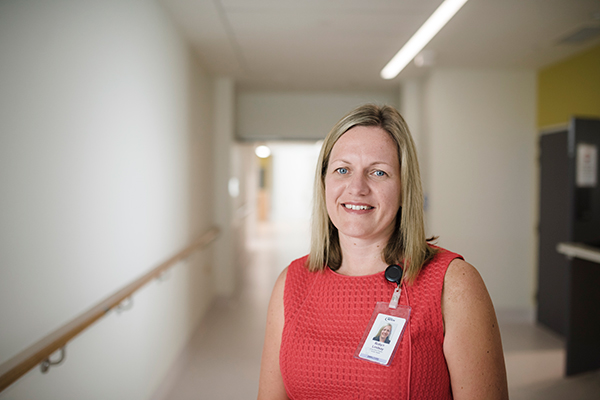
Digital Transformation
Digital Transformation in Healthcare: building a hospital in the Cloud with Microsoft
The new Bendigo Hospital, Victoria’s largest regional acute care health initiative, paves the way for a facility which will ultimately house 372 inpatient beds, 72 same-day beds, 11 new operating theatres, an integrated cancer centre, an 80-bed psychiatry services facility, and a parent-infant unit.
It also heralds the arrival of a transformative information system that streamlines process and workflow in order to optimise outcomes while injecting unprecedented patient transparency.
Transformation teams comprising business analysts, clinical specialists and technical experts first explored how mobility, cloud computing, and Digital Medical Records (DMR) could be used as the foundation for a new class of patient care and health services.
 Instead of episodic care, where each interaction with the patient is based on the issue currently being addressed, Bendigo Health has taken a more holistic patient-centric approach where the treating team’s access to patient information is there at the bedside. This also keeps the patient better informed about their treatment and care.
Instead of episodic care, where each interaction with the patient is based on the issue currently being addressed, Bendigo Health has taken a more holistic patient-centric approach where the treating team’s access to patient information is there at the bedside. This also keeps the patient better informed about their treatment and care.
Danny Lindrea, Director of ICT Architecture explains; “The technologies will go right down to the patient in the bed knowing what medications they’re on, being able to read information about that medication, but also knowing when the medication is due and actually start to manage their health while they’re in hospital as well as out of hospital.” Patients can also use the system to communicate with nursing staff, order their meals, or access the entertainment system.
Clinical integration supports holistic patient care
The transformation has also spurred other important operational reforms. Previously there was little integration between the different clinical areas, says Lindrea. “They had a siloed approach to how they wanted to work. They never thought about where the patient went next, handing off to the next ward.”
Clinical teams might have had to log onto seven or eight separate systems to access the information they required; in all there were 306 separate legacy applications in operation.
According to Robyn Lindsay, executive director of acute health, the opening of the new hospital and implementation of a new information platform has melded; “what was really world-class staffing group with a world-class facility and world-class access to digital technologies.”
 While the operational effects of the transformation have been profound, the technology bones are almost transparent to the end user – be that a clinician, administrator or patient. They simply access the service they require from any device at anytime, anywhere. At the same time a great deal of paperwork has been stripped out of the organisation injecting efficiency and reducing the risk of error.
While the operational effects of the transformation have been profound, the technology bones are almost transparent to the end user – be that a clinician, administrator or patient. They simply access the service they require from any device at anytime, anywhere. At the same time a great deal of paperwork has been stripped out of the organisation injecting efficiency and reducing the risk of error.
At handover, which can now be done at the bedside, there is no delay while a nurse writes their notes, and everyone on the team has real time access to the same digital records.
The foundation platform for the transformation is Azure. Hosted in Microsoft’s local data centres which have IRAP security certification from the Australian Signals Directorate, this approach means DMRs, test results and treatment records can be held in a central, accessible and trusted environment.
Allied health integration extends benefits to broader community
In addition to operating the new hospital, Bendigo Health delivers a range of allied health services, aged care and mental health services. Azure provides the platform for incremental and ongoing reform right across the organisation according to Lindrea. He is already leveraging business intelligence tools (Power BI) to provide instant visibility of patient activity as well as health professional visits being scheduled much more efficiently, while any planned visits to a patient who has been admitted to hospital are immediately suspended.
Bendigo Health is also considering how customer relationship management tools (Dynamics 365) might be deployed to streamline process and workflow, in particular supporting more complex care coordination.
Microsoft’s integration engine (BizTalk) has been leveraged as smart middleware to integrate around 20 separate applications deployed across the enterprise including the scanning solution that can digitise physical records, pathology, radiology and cardiology reports with a clear trail of which information has been received and accessed.
While the initial focus is on enhanced clinical care, over time more allied health services will be rolled onto Azure, followed by Bendigo’s administration. It represents a far more sustainable information systems approach according to Lindrea and has already delivered significant efficiencies.
He notes; “You’ve got data lakes, data storage, you’ve got a really good security layer, workflow tools,” and the opportunity to use Azure analytics to identify health trends, patterns and opportunities.
It means that; “A seven to ten year strategy to get to business analytics and a bit of population health, we’ve realised in about 17 months.”
Bendigo Health is also anticipating saving millions of dollars currently spent on physical storage and retrieval services as a result of having a centralised digitised information store.
Instant access for clinicians and instant insight for executives
Already about a third of Bendigo Health’s staff are using Office 365 and SharePoint to communicate and collaborate. The first cohort of Surface Pro devices running Windows 10 has also been deployed delivering a step change in terms of mobility and flexibility.
Clinicians can now access Azure based services and applications in their office, securely from home, or at the patient bedside – which significantly transforms the doctor-patient relationship. “Click it out of the dock, walk into the patient and I can sit there and show them an X-ray or I can talk them through some drug management or health management, whatever it might be, through the computer as well,” says Lindrea.
As more administration applications transition to Azure, management reporting is also enhanced with self-reporting dashboards delivering operational clarity and revealing where opportunities exist for improvement.
Meanwhile the transparency afforded by having all patient data in a central location means that patient journeys become clear.
As an example, Bendigo Health provides mental health services for 25 per cent of Victoria. Previously the fragmented system meant that case management clinicians might not know what was happening to a patient admitted to hospital until they received the triage report the following day.
By harnessing web services and Azure the patient journey can be revealed in real time and the data made available for instant analysis.
Bendigo Health plays role in Smart City push
Importantly this transformation is being delivered in a non-metro setting. Bendigo has Smart City ambitions, with Smart Health being a key plank in that strategy.
One emerging technology that Lindrea expects to have significant population health benefits is the Internet of Things and wearables where patients might return home, but use wearables or sensors to track, for example, heart rate or blood pressure with that information automatically uploaded and made available to clinical teams.
As Robyn Lindsay notes; “I think it also means a lot for Bendigo as a city to understand that you can lead the world as far as technologies and the provision of health services from a regional centre. You don’t have to be in a metro environment to be able to provide that world-class level of service to the community.”
The solution that Lindrea and his team, along with Microsoft and industry partners, has crafted is already delivering significant benefits. But Lindrea believes that is only the start of a sustained transformation programme.
“The spend in health is phenomenal, absolutely phenomenal,” says Lindrea, adding that any opportunity to inject sustainable solutions is also a chance to elicit greater value with impacts in the form of improved patient-care, reduced sectoral costs and enhanced population health.














